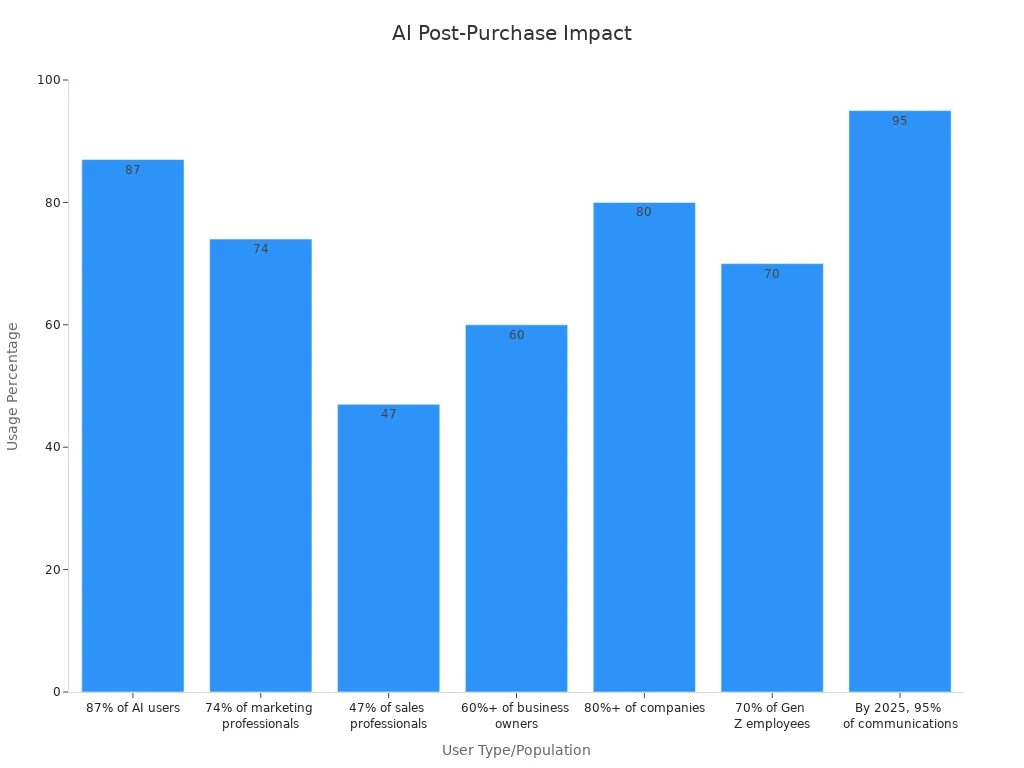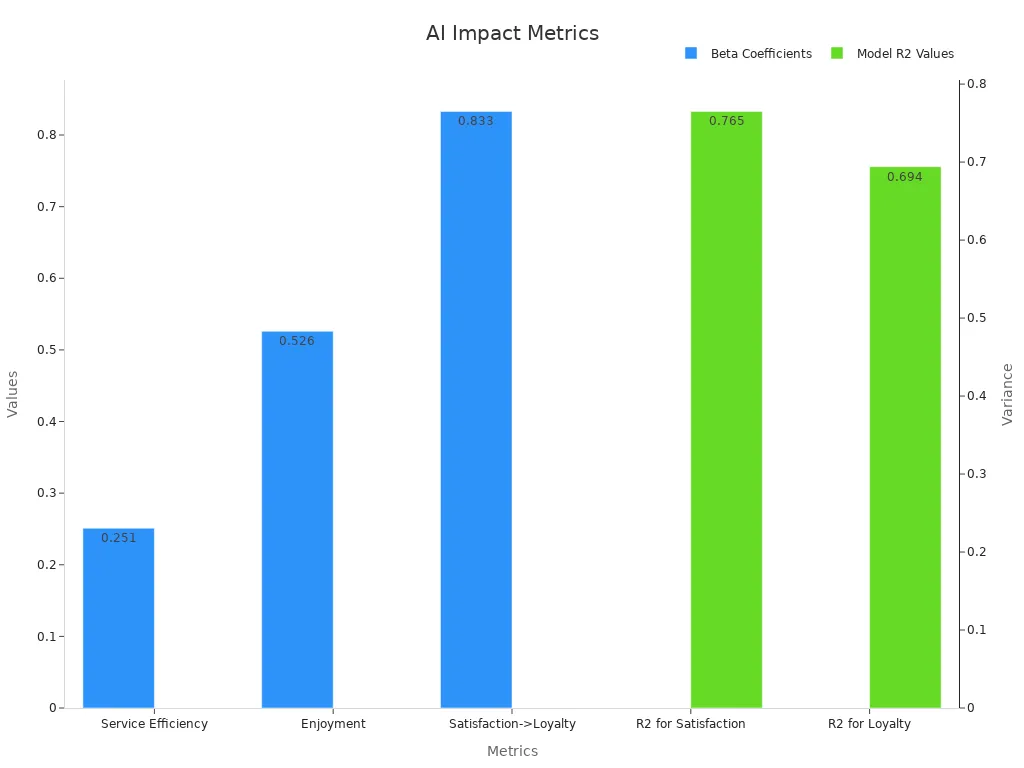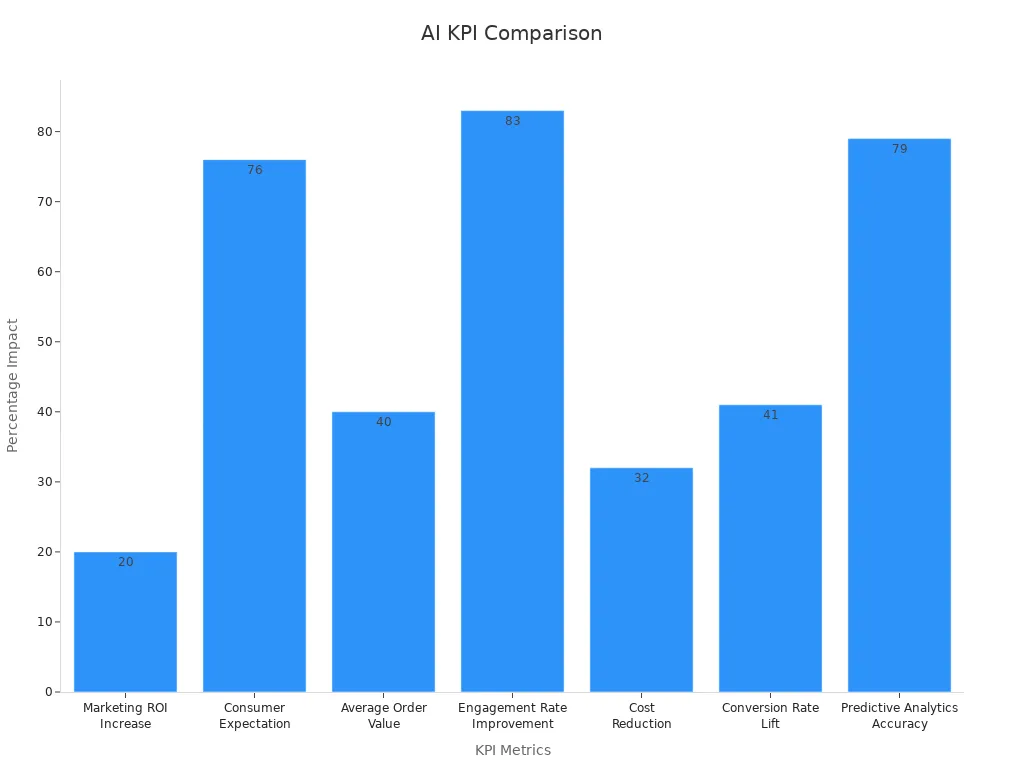The Role of AI in Post-Purchase Content Nurturing

The role of AI is transforming how you interact with customers after they make a purchase. You can see the positive results immediately. Companies report a 20% increase in repeat buyers when they leverage the role of AI for personalized recommendations. Customers receive faster assistance and messages tailored to their preferences. The chart below illustrates the current adoption of AI in the workplace:

Statistic | Description |
|---|---|
Use more AI after adding it to their tools | |
80%+ of companies | See AI as a top priority |
By 2025, 95% of communications | Will use AI-assisted technologies |
By understanding the role of AI, you can boost customer loyalty and satisfaction by keeping them engaged after their purchase. Consider your current processes and how the role of AI could help you improve them.
Key Takeaways
AI lets businesses send messages and offers that fit each customer. This makes customers feel special and can help sales go up.
AI chatbots and tools make customer support faster. They give quick answers all the time. Human agents can then help with harder problems.
AI guesses what customers might do next to keep them interested. This helps businesses send deals at the right time and stop customers from leaving.
AI looks at customer feedback and reviews to spot problems. This helps make service better and keeps customers happy and loyal.
Using both AI and human support helps build trust. Customers want fast help but also real people for tough or caring questions.
Post-Purchase Nurturing

What It Means
Post-purchase nurturing means you keep talking to customers after they buy. The process does not end when someone makes a purchase. You keep building your relationship with them. You might send tips, updates, or special deals. You can also ask for feedback or invite them to join your group. This helps customers feel important and cared for.
You can check if your post-purchase nurturing works by looking at some key numbers. Here is a table that shows ways to see if your plan is working:
Metric | Description |
|---|---|
Conversion Rate | Tells you how many leads move forward after nurturing. |
Engagement Metrics | Counts email opens, clicks, and time spent on your content. |
Lead Quality & Scoring | Shows which customers are most ready to buy again. |
Sales Pipeline Velocity | Measures how fast customers move through your sales steps. |
ROI | Shows if your nurturing brings in more money than it costs. |
Customer Lifetime Value (CLTV) | Tells you how much money a customer brings over time. |
Social Engagement | Looks at likes, shares, and comments on your social posts. |
Multi-Touch Attribution | Helps you see which interactions matter most. |
Funnel Analysis | Lets you find where customers drop off and fix your process. |
Why It Matters
You want customers to come back and buy again. Post-purchase nurturing helps make this happen. Studies show that 96% of people say good service makes them loyal. When you reach out after a sale, you show you care. Many people, about 83%, will share their data if it gives them a better experience.
Personalization is important. About 36% of customers want things made just for them. Companies like Amazon use this to suggest items you might like. This keeps you coming back. Sending the same message everywhere can raise your revenue by up to 23%.
Social media is important too. When you talk to customers online, you build trust. This makes people want to buy again. Repeat customers may only be 21% of buyers, but they bring in 44% of your money. It costs less to keep these customers happy than to find new ones. By caring for customers after they buy, you turn one sale into a long relationship.
Role of AI

Personalization
You can use the role of AI to help each customer feel special after they buy something. AI looks at things like what people have looked at, what they bought before, and what device they use. This lets you send messages and deals that match what each person likes. For example, when you use AI-driven personalization, you might see a 25% jump in marketing ROI. Companies using AI for personalization often see sales go up by 20% or more. Personalized emails can make people buy six times more than normal emails.
Tip: Customers notice when you make things personal. About 71% expect it, and 77% will pay more for brands that do it well.
AI can also help you sort your customers into groups. You can put people together by what they like or how they shop. This helps you send the right message to the right person at the best time. When you use the role of AI for personalization, you get more people interested and they want to come back.
Automated Engagement
The role of AI is great for keeping in touch with customers fast. AI chatbots and voice helpers can answer questions all day and night. This means your customers get help right away, even late at night or on weekends. For example, a money company used an AI chatbot to answer simple questions. This made answers come 60% faster and made customers happier.
You can also use AI to send customers to the best helper for their problem. AI tools give helpers the best answers, so help is quick and right. These tools can make wait times go from 30 minutes to just 5 minutes. More people buy things when you use AI for automated engagement, sometimes over 20% more.
AI chatbots are always awake, so customers get answers anytime.
Smart routing sends people to the right helper fast.
AI gives helpers the best answers to use.
Note: Using AI for automated engagement can cut your marketing costs by up to half. It also helps your team get more done.
Predictive Analytics
You can use the role of AI to guess what your customers will do next. AI looks at things like what people bought, what they said in reviews, and what they post online. It finds patterns that show if someone might stop buying or if they want something new. With predictive analytics, you can talk to a customer before they leave or send them a deal at the best time.
AI uses things like decision trees and neural networks to find trends. These tools help you group customers by risk or what they like. You can then send special messages or deals to keep them interested. Companies using predictive analytics keep more customers and get more repeat sales.
Predictive analytics helps you find customers who might leave.
You can send deals to keep them coming back.
AI models get better over time, so your messages get smarter.
Tip: Watching numbers like churn rate and customer lifetime value helps you see if your AI predictions are working.
Feedback & Sentiment
The role of AI helps you listen to your customers and learn from what they say. AI tools can read reviews, survey answers, and support tickets. They tag topics and check how customers feel. This helps you see what works and what needs to be fixed.
For example, companies like Amazon use AI to look at millions of reviews. They find problems and fix them quickly. In hotels, Marriott uses AI to check reviews from thousands of places. This helps them make things better, like cleaning and staff friendliness.
Company | AI Use Case | Benefit |
|---|---|---|
Looks at reviews and support tickets for trends | Better products and more sales | |
James Villas | AI for support ticket analysis | 46% faster replies, happier customers |
Butternut Box | Uses surveys and ticket feedback with AI | Understands customer needs better |
Motel Rocks | AI-powered sentiment analysis | 9.44% higher satisfaction, fewer complaints |
T-Mobile | AI checks customer feelings in requests | Fewer complaints, better service |
AI can also send out surveys after a customer talks to your team. This helps you see if customers are happy and find ways to get better. When you use the role of AI to track feedback and sentiment, you make smarter choices and keep your customers happy.
Business & Customer Benefits
Satisfaction & Loyalty
You want your customers to feel happy and keep buying from you. AI helps you check how satisfied your customers are by looking at scores like CSAT, NPS, and CES. These scores show if you meet customer needs and if they will come back. AI tools like Insight7 and Qualtrics help you find patterns in feedback and spot problems early. When you use AI to make service better, you can see a strong link between satisfaction and loyalty.

Tip: Studies show that when loyalty programs match what customers like, loyalty can go up by 60%. AI also helps you learn what makes people return, so you can focus on those things.
Upsell & Cross-Sell
AI makes it easier to offer more products to your customers. Voice AI agents like Dasha talk with customers and suggest new items or upgrades. Tools like Salesforce Einstein Analytics and Amazon Personalize use data to recommend products that fit each customer’s needs. This leads to more sales and happier customers.
Metric / Outcome | Description |
|---|---|
Lead Conversion Increase | 50% more leads turn into sales with AI-driven upsell and cross-sell models |
Sales Pipeline Health | Gets better by automating lead generation and improving targeting |
Customer Retention | AI churn prevention models help stop revenue loss |
Dynamic Pricing | AI changes offers and discounts to encourage more purchases |
AI learns from every sale, so your offers get smarter and more personal over time.
Efficiency & Savings
AI helps you save time and money by making your business run smoother. You can use AI to automate tasks like order processing and invoice approvals. Predictive analytics help you avoid having too much or too little stock. Early users of AI have seen up to a 15% drop in logistics costs and a 20-30% cut in sourcing event times.
Aspect | Evidence of Cost Savings / Efficiency Improvement |
|---|---|
Sourcing Event Time Reduction | 20-30% less time spent on sourcing events with automation |
Logistics Cost Reduction | Up to 15% lower logistics costs |
Inventory Cost Management | Predictive analytics stop extra inventory costs |
ROI Recognition | 70% of CEOs say they see strong ROI from AI investments |
When you use AI, your team has more time to help customers and grow your business.
Challenges
Data Privacy
You face real challenges when you use AI for post-purchase content. Data privacy stands out as one of the biggest concerns. Customers trust you with their information, so you must protect it. Many people worry about how companies use their data. In fact, 68% of consumers feel concerned about online privacy, and 57% believe AI poses a significant privacy threat. About 81% think companies use their data in ways that make them uncomfortable.
You need to follow strict rules like the GDPR in Europe. These laws push companies to use less data and focus on privacy. This shift changes how you build AI tools and can slow down new ideas. You must get clear consent from customers and explain how you use their data. You should also give customers easy ways to opt out.
Always ask for clear, informed consent before collecting data.
Protect data from unauthorized access.
Let customers control their data and opt out at any time.
Regularly check your AI systems for fairness and bias.
Tip: Explain to your customers why you collect data and how it helps them. This builds trust and keeps you in line with privacy laws.
Human Touch
AI can help you answer questions fast, but it cannot replace the human touch. Many customers still want to talk to real people, especially when they have complex problems. A survey shows that 47% of people feel uncomfortable with AI-only service. About 86% prefer human interaction for empathy and trust.
You should use AI to help, not replace, your team. Customers want to know that someone understands their feelings and can solve tricky issues. AI works best on web chat or SMS, but people prefer humans on phone calls and social media.
Use AI for simple tasks and quick answers.
Make it easy for customers to reach a human when needed.
Train your team to handle sensitive or complex cases.
Be honest about when customers are talking to AI.
Collect feedback to improve both AI and human service.
Customers trust you more when they know a real person can help them if needed. Balance AI with human care to keep everyone happy.
Best Practices
Tool Selection
Choosing the right AI tools helps you get the most from your post-purchase content strategy. Start by looking at your biggest challenges. Do you need better personalization or faster replies? Pick tools that solve these problems first.
Look for AI tools that fit your current marketing system. Make sure they are easy to use and can grow with your business.
Test new tools with small projects. Set clear goals and measure results before using them everywhere.
Train your team so everyone knows how to use the tools well.
Start with simple tasks like email personalization. Add more features as you learn.
Watch how the tools perform. Use data like conversion rates and engagement to see what works.
Keep your customers’ data safe. Make sure the tools follow privacy rules and avoid bias.
You also want AI tools that match your brand’s voice. Train them with your style guides and past content. Use AI to learn about your audience in real time. This helps you send the right message at the right time, on the right channel.
Metric Type | Description and Use Case |
|---|---|
Compare AI text to human writing for quality. | |
Human Evaluation | Real people check tone, clarity, and creativity. |
Conversion Rates | Show how well AI content drives sales or sign-ups. |
Brand Consistency | Checks if AI content matches your brand’s style. |
Ongoing Optimization
You need to keep improving your AI tools to get the best results. AI works best when you use real-time data to adjust your strategy. For example, companies have seen a 47% jump in lead conversions after using AI to score and target customers.
Use AI to watch how customers behave and change your messages quickly.
Let AI automate follow-ups and suggest new content based on what works.
Connect AI with your CRM to track results and make changes fast.
Use predictive analytics to guess what customers want next and act early.
Collect feedback from users and check key numbers like engagement and sales.
Tip: Mix AI automation with human support. Let AI handle simple tasks, but keep people ready for complex questions.

AI can help you deliver more personal content, boost engagement, and save time. When you keep testing and improving, you make sure your post-purchase nurturing stays strong and effective.
You have learned how the role of AI changes post-purchase nurturing for you and your customers. AI helps you find problems quickly and fix them fast. This keeps your customers happy and loyal. The table below shows how AI makes business better and helps customers:
Aspect | Business Impact | Customer Impact |
|---|---|---|
Real-time AI Monitoring | Faster choices, better planning | Quick help, more satisfaction |
AI Feedback Analysis | Smarter decisions, more sales | Personal service, more trust |
Start by using AI tools to watch feedback and send personal messages. As AI gets better, you will find new ways to connect with customers and build strong relationships.
FAQ
How does AI personalize post-purchase content?
AI studies your customers’ past actions and preferences. You can use this data to send messages, offers, or tips that match what each person likes. This makes your customers feel valued and keeps them engaged.
Can AI help reduce customer service workload?
Yes! AI chatbots answer common questions quickly. You can let your team focus on complex issues. This saves time and improves your customer support.
Tip: Use AI for simple tasks and let humans handle special cases.
Is customer data safe when using AI tools?
You must protect customer data. Choose AI tools that follow privacy laws like GDPR. Always explain how you use data and let customers opt out if they want.
What are the main benefits of AI in post-purchase nurturing?
Faster replies for customers
Personalized offers and tips
Higher customer loyalty
You can boost satisfaction and sales by using AI in your strategy.
Will AI replace human support completely?
No. AI helps with quick answers and simple tasks. You still need humans for empathy and complex problems. Customers trust you more when they know real people can help.
See Also
Exploring Key B2B Content Marketing Trends For 2024
Writesonic AI And QuickCreator Face Off In Content Creation
Comprehensive Strategies For Achieving SaaS Content Marketing Success
Complete Guide To Mastering SEO Using Perplexity AI Tools
Five Effective Ways To Boost Healthcare Content Marketing Results

